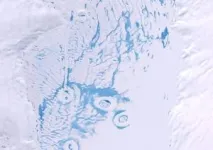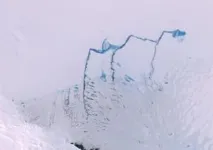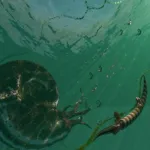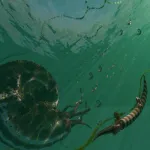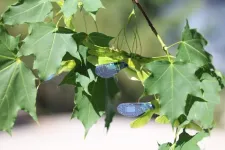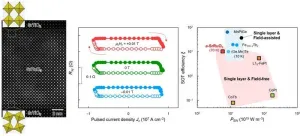(Press-News.org) Slush – water-soaked snow – makes up more than half of all meltwater on the Antarctic ice shelves during the height of summer, yet is poorly accounted for in regional climate models.
Researchers led by the University of Cambridge used artificial intelligence techniques to map slush on Antarctic ice shelves, and found that 57% of all meltwater is held in the form of slush, with the remaining amount in surface ponds and lakes.
As the climate warms, more meltwater is formed on the surface of ice shelves, the floating ice surrounding Antarctica which acts as a buttress against glacier ice from inland. Increased meltwater can lead to ice shelf instability or collapse, which in turn leads to sea level rise.
The researchers also found that slush and pooled meltwater leads to 2.8 times more meltwater formation than predicted by standard climate models, since it absorbs more heat from the sun than ice or snow. The results, reported in the journal Nature Geoscience, could have profound implications for ice shelf stability and sea level rise.
Each summer as the weather warms, water pools on the surfaces of Antarctica’s floating ice shelves. Previous research has shown that surface meltwater lakes can contribute to ice shelf fracture and collapse, as the weight of the water can cause the ice to bend or break. However, the role of slush in ice shelf stability is more difficult to determine.
“We can use satellite imagery to map meltwater lakes across much of Antarctica, but it’s hard to map slush, because it looks like other things, such as shadows from clouds, when viewed from a satellite,” said lead author Dr Rebecca Dell from Cambridge’s Scott Polar Research Institute (SPRI). “But using machine learning techniques, we can go beyond what the human eye can see and get a clearer picture of how slush might be affecting ice in Antarctica.”
Using optical data from NASA’s Landsat 8 satellite, the Cambridge researchers, working with researchers from the University of Colorado Boulder and the Delft University of Technology, trained a machine learning model to obtain monthly records of slush and meltwater lakes across 57 Antarctic ice shelves between 2013 and 2021.
“Machine learning allows us to use more information from the satellite, since it can work with more wavelengths of light than the human eye can see,” said Dell. “This allows us to determine what is and isn’t slush, and then we can train the machine learning model to quickly identify it across the whole continent.”
“We’re interested in learning how much slush is present during the Antarctic summer, and how it’s changed over time,” said co-author Professor Ian Willis, also from SPRI.
Using their machine learning model, the researchers found that in the peak of the Antarctic summer in January, over half (57%) of all meltwater on Antarctica’s ice shelves is held in slush, with the remaining 43% in meltwater lakes.
“This slush has never been mapped on a large scale across all of Antarctica’s large ice shelves, so over half of all surface meltwater has been ignored until now,” said Dell. “This is potentially significant for the hydrofracture process, where the weight of meltwater can create or enlarge fractures in the ice.”
Meltwater affects the stability of the floating ice shelves that fringe the Antarctic coastline. As the climate warms and melt rates in Antarctica increase, meltwater – whether in the form of lakes or slush – can get into cracks on the ice, causing the cracks to get bigger. This can cause fractures in the ice shelf, and could cause vulnerable ice shelves to collapse, which in turn would allow inland glacier ice to spill into the ocean and contribute to sea level rise.
“Since slush is more solid than meltwater, it won’t cause hydrofracture in the same way that water from a lake does, but it’s definitely something we need to consider when attempting to predict how or whether ice shelves will collapse,” said Willis.
In addition to the potential implications of slush on hydrofracture, it also has a large effect on melt rates. Since slush and lakes are less white than snow or ice, they absorb more heat from the sun, causing more snowmelt. This extra melt is currently unaccounted for in climate models, which may lead to underestimates in projections of ice sheet melting and ice shelf stability.
“I was surprised that this meltwater was so poorly accounted for in climate models,” said Dell. “Our job as scientists is to reduce uncertainty, so we always want to improve our models so they are as accurate as possible.”
“In future, it’s likely that places in Antarctica that currently don’t have any water or slush will start to change,” said Willis. “As the climate continues to warm, more melting will occur, which could have implications for ice stability and sea level rise.”
The research was supported in part by the European Space Agency and the Natural Environment Research Council (NERC), part of UK Research and Innovation (UKRI). Rebecca Dell is a Fellow of Trinity Hall, Cambridge.
END
Antarctic ice shelves hold twice as much meltwater as previously thought
2024-06-27
ELSE PRESS RELEASES FROM THIS DATE:
First specific PET scan for TB could enable more effective treatment
2024-06-27
A more accurate way to scan for tuberculosis (TB) has been developed by UK and US researchers, using positron emission tomography (PET).
The team, from the Rosalind Franklin Institute, the Universities of Oxford and Pittsburgh and the National Institutes of Health in the USA, have developed a new radiotracer, which is taken up by live TB bacteria in the body. Radiotracers are radioactive compounds which give off radiation that can be detected by scanners and turned into a 3D image.
The new radiotracer, called FDT, enables PET scans to be used for the first time ...
Ammonites’ fate sealed by meteor strike that wiped out dinosaurs
2024-06-27
Ammonites were not in decline before their extinction, scientists have found.
The marine molluscs with coiled shells and one of palaeontology’s great icons flourished in Earth’s oceans for more than 350 million years until they died out during the same chance event that wiped out the dinosaurs 66 million years ago.
Some palaeontologists have argued that their demise was inevitable and that ammonite diversity was decreasing long before they went extinct at the end of the Cretaceous.
However new research, published today in Nature Communications and led by palaeontologists at the ...
New mathematical model sheds light on the absence of breastfeeding in male mammals
2024-06-27
Being nursed by a single parent could be an evolutionary strategy to curb the spread of harmful microbes in mammals, according to a novel theory developed by mathematicians.
The rainforests of Malaysia are home to the only known case of a wild male mammal that produces milk. The Dayak fruit bat is a vanishingly rare case of male milk production, despite the fact that the potential for breastfeeding remains in place in most male mammals.
In the 1970s, evolutionary theorists posited that the near absence of ...
Ammonites went out with a diverse bang—and not a long, slow fizzle—in the Late Cretaceous
2024-06-27
Los Angeles, CA (June 27, 2024) —A new study published in the journal Nature Communications led by paleontologists at the University of Bristol along with a team of international researchers, including Dr. Austin Hendy, Curator of Invertebrate Paleontology at the Natural History Museum of Los Angeles County, finds that instead of fizzling out ahead of their extinction, ammonoids were still going strong across the globe in the Late Cretaceous. Made possible by museum collections, the new study compared their diversity across the globe just prior to extinction, unearthing the complex evolutionary history ...
Cleveland Clinic launches wellness and diet coaching app featuring state-of-the-art food and fitness tracking, support and education
2024-06-27
Embargoed until 4am EDT Cleveland, OH (Thursday, June 27, 2024) – Cleveland Clinic and app developer FitNow, Inc. have launched the Cleveland Clinic Diet app, which offers health and diet advice built upon evidence-based nutrition science and clinical success, paired with a comprehensive food and fitness tracker.
The app provides individualized guided support with the input of Cleveland Clinic health experts to help users make sustainable changes to their lifestyle and dietary habits for better health and well-being.
“We know that health is about far more than just weight. ...
Light-controlled artificial maple seeds could monitor the environment even in hard-to-reach locations
2024-06-27
Researchers from Tampere University, Finland, and the University of Pittsburgh, USA, have developed a tiny robot replicating the aerial dance of falling maple seeds. In the future, this robot could be used for real-time environmental monitoring or delivery of small samples even in inaccessible terrain such as deserts, mountains or cliffs, or the open sea. This technology could be a game changer for fields such as search-and-rescue, endangered species studies, or infrastructure monitoring.
At Tampere University, Professor Hao Zeng and Doctoral Researcher Jianfeng Yang ...
Patients receiving protocol exceptions to participate in targeted therapy trial experienced similar outcomes as eligible participants
2024-06-27
Bottom Line: Patients with treatment-refractory cancers who received eligibility and testing waivers to participate in a large basket/umbrella oncology trial had similar rates of clinical benefit and adverse events as patients who participated in the trial without waivers.
Journal in Which the Study was Published: Clinical Cancer Research, a journal of the American Association for Cancer Research (AACR)
Author: Hans Gelderblom, MD, senior author of the study and chair of the Department of Medical Oncology at the Leiden University Medical Center in the Netherlands
Background: Eligibility requirements ...
Magic mushrooms are the most-used psychedelic drug
2024-06-27
Psilocybin mushrooms are the psychedelic substance most often used in the U.S., with its popularity outpacing other psychedelic drugs such as MDMA (known as ecstasy), according to a new RAND report.
Based on a new national survey, researchers found that about 12% of respondents reported using psilocybin at some point over their lives and 3.1% reported using the substance over the past year. An estimated 8 million American adults used psilocybin in 2023.
Psychedelic substances such as psilocybin mushrooms and MDMA long have been touted as holding promise for treating various mental ...
Diagnostic stewardship approach to C. diff reduces unnecessary testing
2024-06-27
Arlington, Va. — June 27, 2024 — A new study published today in the American Journal of Infection Control (AJIC) describes the outcome of a new approach to testing for Clostridioides difficile (C. diff) guided by the principles of diagnostic stewardship. At Memorial Healthcare System in Hollywood, Fla., revised rules for when C. diff tests could be ordered helped to reduce inappropriate testing by 20%, which in turn can help rein in the overtreatment of patients.
C. diff is a common and potentially dangerous gastrointestinal pathogen, often linked to healthcare-associated infections ...
Materials research revolutionized by a small change
2024-06-27
Like the flutter of a butterfly's wings, sometimes small and minute changes can lead to big and unexpected results and changes in our lives. Recently, a team of researchers at Pohang University of Science and Technology (POSTECH) made a very small change to develop a material called “spin-orbit torque (SOT),” which is a hot topic in next-generation DRAM memory.
This research team, led by Professor Daesu Lee and Yongjoo Jo, a PhD candidate, from the Department of Physics and Professor Si-Young ...

